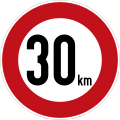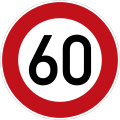kilometers per hour
| Physical unit | |
|---|---|
| Unit name | kilometers per hour |
| Unit symbol | |
| Physical quantity (s) | speed |
| Formula symbol | |
| dimension | |
| system | Approved for use with the SI |
| In SI units | |
| In CGS units | |
| Derived from | Kilometers , hours |
| See also: meters per second | |
Kilometers per hour , colloquially kilometers per hour , more rarely kilometers by hour , kilometers per hour or kilometers per hour ( unit symbol : km / h ), is a unit of speed . It is mainly used in transport , for example for speed in road traffic or for travel speed , since distances are usually given in kilometers and times in hours - instead of meters and seconds, which is the SI unit of speedm / s is based. The two related metrics have the same magnitude .
definition
An object moving at 1 km / h for an hour travels a distance of one kilometer . The distance and the speed remain proportional.
Name and use
Colloquially , the spoken form "ka-em-ha" is often used, which also leads to the writing "kmh" instead of "km / h". Just like kilometers per hour , this is (physically) technically incorrect, since this sequence would stand for the product kilometers times hours . The Society for German Language points out that in the theory of word formation for compound words the relationship of the word components is not subject to any rules and the term kilometers per hour is absolutely correct and appropriate . In doing so, she warns against linguistic pedantry, as this will not lead to anything. When it comes to the speeds of motor vehicles, a designation is often completely dispensed with (“He was flashed with 120 at the construction site ”), as is the case with the representation of speeds on the corresponding traffic signs.
For a long time, traffic signs were used in Germany and Austria that only contained the unit “km” (without the “/ h”). In Germany, this goes back to the ordinance on warning signs for motor vehicle traffic of July 8, 1927 , a forerunner of today's road traffic regulations . More important than these national regulations, however, were the global conventions on road traffic signs. Both the sign 274, introduced in the Federal Republic of Germany in 1971, and the regulatory sign used in Austria at the time, coincided in this way with the Vienna Convention on Road Traffic Signs of November 8, 1968, which Austria and the Federal Republic of Germany (1977) also signed and signed had ratified. This resulted in a request in the German Bundestag in January 1985 , which dealt with the problem of incorrect unit information. The ratified text read: “After or below the speed figure, 'km' (kilometers) or 'm' (miles) can be added.” Regardless of this, the Federal Ministry of Transport had already planned at this point to dispense with any unit information. The reason, however, was not the use of the term “km”, but the increasingly popular electronic variable message signs . Here an additional unit specification would have caused unnecessary technical problems. Therefore, in the ninth ordinance amending the road traffic regulations of March 22, 1988, it was stipulated that the previous sign would lose its meaning as an official traffic sign after December 31, 1998.
The abbreviations km / h or km / h were also used until the 1960s and occasionally until the 1980s.
- Sign for speed restrictions in Germany and Austria
Conversion between km / h and m / s
The unit km / h is often preferred to the SI unit m / s ( meters per second ). This is how you can convert the two associated dimensions into each other:
So:
Other units of measure

In some countries, such as the US or UK , where the metric system is not mandatory, speeds are often given in miles per hour (mph) (1 mph = 1.609 km / h). In nautical science and aviation , speed specifications in knots (kn), i.e. nautical miles per hour, are common (1 kn = 1.852 km / h).
Web links
Individual evidence
- ↑ Designation kilometers per hour. Questions and answers. In: gfds.de. Society for the German Language , accessed on June 5, 2019 .
- ^ Ordinance on warning signs for motor vehicle traffic of July 8, 1927. In: Reichsgesetzblatt. Year 1927, No. 29, date of issue: Berlin, July 15, 1927. Scan
- ↑ Printed matter 10/2827 . In: Negotiations of the German Bundestag , 10th electoral period, printed matter, Volume 314, p. 39.
- ^ Ninth ordinance amending the road traffic regulations . In: Federal Law Gazette Part I, 1988, No. 12 of March 30, 1988. A subsequent amendment to the StVO under Federal Transport Minister Peter Ramsauer , who has been active since 2009, repealed this regulation for the older signs that were still in place.
- ^ Reichsgesetzblatt 123 of November 16, 1937, p. 1213.
- ↑ Replacement of new traffic signs by March 31, 1955. In: Verkehrsblatt. 1953, No. 289, p. 331.
- ↑ Federal Law Gazette . Born 1953, No. 56, date of issue: Bonn, September 3, 1953, p. 1226.
- ↑ Rolf Jedicke: Ordinance on behavior in road traffic - Road Traffic Regulations (StVO) - from October 4, 1956. In: Der deutsche Straßenverkehr. Special issue, November 1956.
- ↑ Federal Law Gazette . Born 1956, No. 19, date of issue: Bonn, May 29, 1956, p. 358.
- ↑ Federal Law Gazette . Year 1970, No. 108, date of issue: Bonn, December 5, 1970, p. 1589.




















